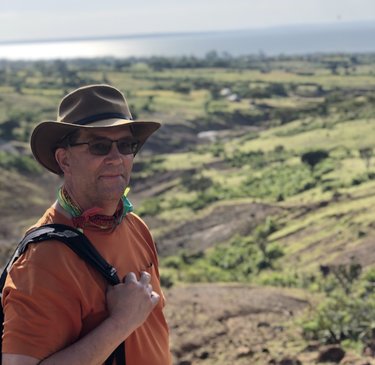Anthropologist Plummer asks: Who made the earliest stone tools?
On the very last day of the dig, a thunderstorm was coming in from Lake Victoria in Kenya.
“My graduate student … was up on top of the hill with a laser transit, which is a big metal contraption used for surveying,” recalled Thomas W. Plummer, who was overseeing the archaeological excavation.
“I was worried about her being on the hill with the lightning coming … But we had like 200, 300 things to lift and you’ve got to take the coordinates with this laser transit of each thing before you pick it out of the ground so you can reconstruct the distribution of objects in the excavation.”
The others in the group knew that Plummer was about to see something stunning; they had kept it quiet.
Just as he began to feel the raindrops on the last day of the season, Plummer picked up an object.
“I’m looking at this and it’s like, wow, this is a hominin tooth …. It was a Paranthropus tooth …. Everybody was smiling at me because they hadn’t told me — they wanted me to be surprised.”
Plummer, an anthropology professor at Queens College, is the lead author on the study that was published last month in Science. The discoveries made at Nyayanga on Kenya’s Homa Peninsula could change our understanding of the origins of toolmaking.
Early humans may not have been the only ones making and using stone tools.
Anthropologists have long thought that the Oldowan tools were used solely by members of the Homo genus, ancient relatives of humans. But Plummer’s team discovered two molars belonging to the hominin Paranthropus, a different genus than Homo.
Homo sapiens didn’t appear in Africa until about 300,000 years ago and the site where the Paranthropus molar, one of two, was found is closer to 3 million years old. “So it’s way before Homo sapiens,” says Plummer.
Taking a step back to provide context, Plummer explains in this week’s Enterprise podcast, “Humanity is a technologically dependent species … Our survival is dependent on technology.”
Referencing the reality television show, Naked and Afraid, he says, “If you drop people into contexts where they have nothing, they’re going to die unless they make technology to gather food, unless they make shelters, unless they generate fire … So when does evidence of that first appear in the geological record?”
The earliest archaeological sites go back almost 3.3 million years. “Our species isn’t around then,” says Plummer. “These are precursors to humanity.”
Plummer has spent decades studying the earliest technologies to see when dependency first occurred. The couple Mary and Louis Leakey coined the term Oldowan tools based on their finds at the Olduvai Gorge in Tanzania.
Early tools, Plummer explains, are used to manipulate materials in the environment. He holds up a rock from which flakes have been knocked off. “These sharp flakes can be used as knife blades,” he says. “So you’ve got basically a pounding technology and a cutting technology.”
The knives can be used to butcher animals, clean off tubers, or make wooden tools. The rocks for pounding can be used to pulverize food.
“Everything’s being eaten raw at this point. There’s no cooking. So when they’re eating hippo, for example, it’s hippo tartare.”
Having stone tools was “a huge breakthrough,” says Plummer. “I don’t think we’d be here today talking on computers if this technology hadn’t come about because what you see during the course of human evolution is an increase in brain size over time. And that’s being fueled by changes in the diet and the dietary improvements you get.”
Not only did better nutrition, accessible through tools, lead to bigger brains but also to bigger body size.
For most of human evolution, Plummer explains, there were multiple species of humans — all much smaller than today’s humans — in different parts of the world. “The fact that we’re alone today is an anomaly,” he said.
The two molars that were uncovered at the Nyayanga site predate Homo sapiens. “These molars are from a really big-toothed, big-jawed kind of human relative called Paranthropus,” said Plummer, describing molars with four times the surface area of our molars.
“Their bicuspids are also like molars and they’ve got itty-bitty incisors in the front and canines. So they’re doing very little nipping; they’re doing a lot of chewing,” he said, probably of underground storage organs, tubers, wild versions of our beets and potatoes.
“They’re not directly ancestral to us,” said Plummer. “Their line parallels the genus Homo for more than a million years and then they go extinct.”
So, until the Kenyan discovery, it was thought Parantrhopus did not make tools. A platypus tooth was found at the site but no Homo teeth. The site also revealed a hippopotamus had been butchered.
“So then, the question is: Was Paranthropus using stone tools?”
Plummer plans to return to Kenya to find answers to that question and more.
He first started working in Kenya more than 20 years ago as a graduate student at Yale with his advisor, Rick Potts. Potts is now a curator at the Smithsonian Institution in the Human Origins Program at the National Museum of Natural History and is co-director of the project.
Plummer also credited the National Museum of Kenya on the project, describing it as a world-renowned institution.
“I work with people from the University of Rome, from Oxford … you pull in specialists and try to get people involved who can help with the project,” he said.
Plummer speaks enough Swahili to direct the excavations, he said, but most of the people living in the region speak Luo. He noted that Barack Obama’s father was from the Luo tribe.
Many disciplines are needed at the site — for example, to date specimens, not only is geology used but so is an expert on pigs.
Plummer explains, “There are lots of species of pigs during the course of human evolution and they evolve very rapidly.” So a particular species of pig fossil at a site can identify its age.
Plummer has received funding from the National Science Foundation, the Leakey Foundation, the Smithsonian, National Geographic, and more.
A single season can cost tens of thousands of dollars “with vehicle rentals, with the airfares, with hiring people to excavate,” said Plummer. “We’ve been training local people to excavate, and many of them are now much better excavators than me.”
These excavators are hired year after year. “Because they come from near the sites, they’re interested in what’s going on and they help protect the sites too,” said Plummer. Tours are also given to schoolchildren in Kenya.
Kenya, he says, has “multiple chapters of the origins of humanity — and you can’t see that in many other places in the world.”
Plummer grew up in an old farmhouse outside of Guilderland Center on a few acres of cultivated land. His father, a biochemist who worked for New York State, still lives there.
As a kid, Plummer liked being outdoors, catching frogs and crayfish and minnows in the nearby Black Creek.
“I was outside all the time, working,” said Plummer of tending to the corn and other vegetables his family grew to eat.
“We found some Native American artifacts,” he said.
The tedious work outdoors prepared him for work as an archeologist.
“I was used to being out in the sun, doing kind of mind-numbing work, which is what a lot of archeology is. When you start out, right, you’re just digging. You don’t know what you’re going to find … So it’s the treasure-hunting aspect of it — but sometimes you find nothing.”
At the site in Kenya now, Plummer says, “You never know what’s going to pop out.”
Once, after a rainstorm, his son found a 2 million-year-old lion’s tooth.
There was an ancient stream at the site. “It was just an idyllic setting,” Plummer said. “So if you could avoid the saber-tooth cats up in the trees, then you were probably pretty good.”
Before human ancestors had fire, he noted, they slept in trees. Because of the lions and hyenas, he said, “You’re dead meat if you’re on the ground at night.”
Plummer can vividly imagine a world from millions of years ago where human ancestors were creatures like any other.
He says he’s had a good imagination since he was a kid.
That helps him as an archeologist, he said. “You’re thinking about places that may not look exactly like anywhere that exists today. So you need to sort of use the evidence you have in front of you from the geology and the plant remains and the animal remains and the stone tools — and try to put it together in a way that is as true as you can make to what existed in the past.”
Plummer says of the ancient humans, “There was no dominance over all other life forms … They may have modified the landscape somewhat, but not as much as elephants or other animals do.”
Even in Homo sapien history, Plummer said, “What we see today is completely different …. Cities and population growth is only happening after agriculture and domestication … Sites older than 20,000 years ago, it’s all hunter-gatherers, it’s all foraging peoples ….
“You have to imagine what it was like without screens, without any technology, just you on the landscape, surviving by your wits and knowing what plant foods were edible and learning how to make stone tools by watching the people around you.”



